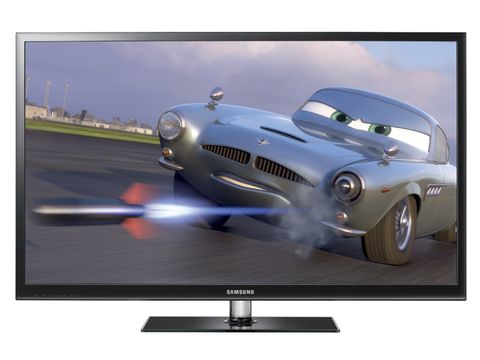Why you can trust TechRadar

Pictures manage to impress and mildly disappoint simultaneously.
The sheer scale of the image underlines how 3D works better when it occupies a bigger chunk of your field of vision, with the full HD nature of the active 3D format proving abundantly obvious. Aside from a touch of motion blur, 3D Blu-ray images are every bit as detailed and crisp as 2D Blu-rays, providing a reminder of the advantages of the active method over passive and unlike, say, the LG's 55LW650T's, there's no trace of horizontal lines across the screen.
The PS64D8000's pictures are also impressively bright and richly coloured for a 3D plasma TV.
Samsung's Bluetooth-based glasses don't knock as much brightness out of pictures as those of some rival brands and the screen itself has enough dynamism in its images to avoid the murky colours and detail-free dark areas that were associated with some 3D plasmas last year.
In fact, its 3D pictures seem slightly brighter than those of Panasonic's 2011 3D plasmas.
At first, it also looked like the PS64D8000 was going to do the business where crosstalk was concerned. Notoriously problematic material, such as the Golden Gate Bridge sequence in Monsters Vs Aliens, are very clean, with scarcely a trace of the tell-tale double ghosting noise.
It fares worse, however, with a scene in Tangled where hundreds of bright lanterns floating against a dark sky appear with obvious double echoes of themselves to either side.
Any light elements in predominantly dark 3D sequences also suffer from ghosting, especially if they are in the middle to far distance.
This dark-scene crosstalk is done no favours by the gargantuan panel, which makes flaws difficult to ignore.
The PS64D8000 is more consistently successful with 2D. Its upscaling engine transposes standard-definition sources, including low-quality Freeview/Freesat channels and streamed material from the internet, to the 1080p screen remarkably well. Even the softest sources look detailed and sharp and, impressively for a 65-inch screen, this is achieved with a negligible amount of noise.
While standard-def playback is superb, the PS64D8000's HD pictures are among the best on the market.
The new contrast filter enables black parts of pictures to look several degrees deeper, and more convincing than on the PS51D6900 and at no expense to shadow detail. What's more, this being plasma rather than LCD or LED , the inky blacks can effortlessly share a frame with punchy, dynamic bright content.
Detail levels with quality HD sources are immense, too, giving pictures the level of nuance that distinguishes the very best TVs and projectors.
The PS64D8000's motion handling, meanwhile, be it with 1080p/24 Blu-ray or normal standard-def fodder, is the most natural (in terms of not suffering judder or resolution loss) that Samsung has delivered for a very long time.
Colours are explosive, even using the relatively restrained Movie picture preset. Furthermore, it doesn't take much work in the colour adjustment menus – even though these don't include secondary adjustments – to get hues looking as credible as they are vibrant, while even the subtlest shifts or blends are handled without banding or blocking.
Add to all this plasma's advantage when it comes to viewing angles, and it's hard to fault the PS64D8000's 2D HD performance, especially given its price compared to its main rivals. Some skin tones and deep reds can look a touch orangey, especially during standard-def viewing and brightness levels jump around slightly with the Dynamic preset, but these flaws are not sufficiently regular or aggressive to raise a red flag.
One smaller concern is that the image looks rather 'fizzy' (as most plasmas do to some extent) if you get close to the screen, but this noise vanishes at a sensible viewing distance.
Finally, in the negative column, the PS64D8000's input lag is a bit disappointing. The provided Game preset records an average of 60ms, which is enough to compromise your performance.
Current page: Samsung PS64D8000: Picture
Prev Page Samsung PS64D8000: Features Next Page Samsung PS64D8000: Sound, value and ease of useAV Technology Contributor
John has been writing about home entertainment technology for more than two decades - an especially impressive feat considering he still claims to only be 35 years old (yeah, right). In that time he’s reviewed hundreds if not thousands of TVs, projectors and speakers, and spent frankly far too long sitting by himself in a dark room.


